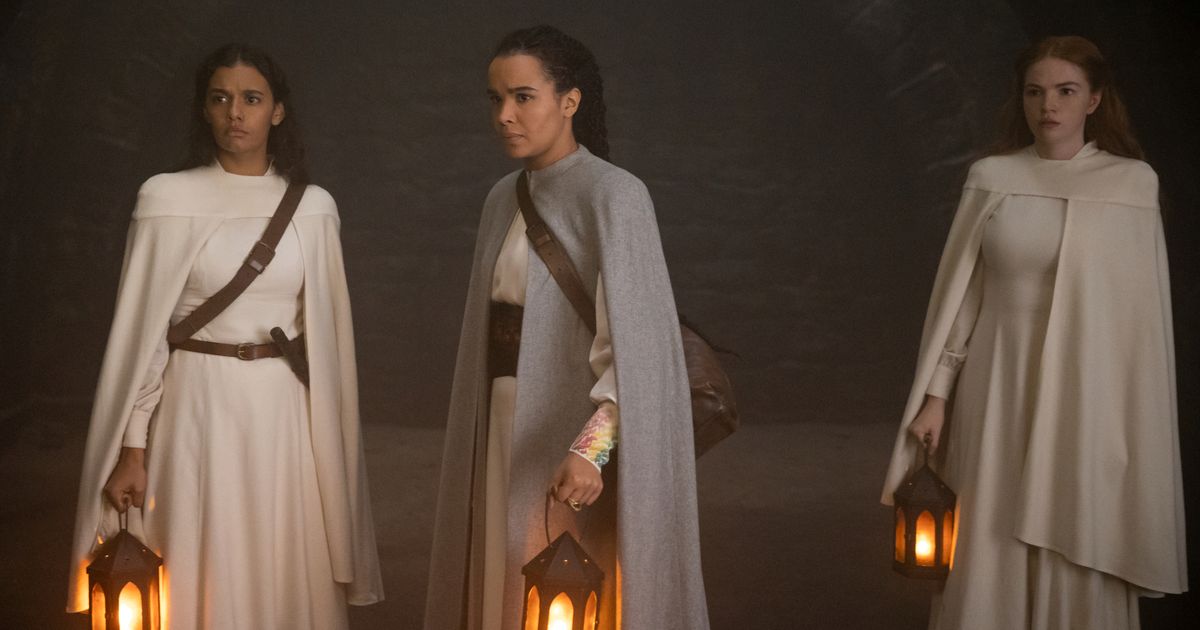
The Wheel of Time Recap: Rand on the Run
Season 2 Episode 2 Editor’s Rating3 stars ***
Photo: Jan Thijs/Prime Video It’s probably not a great sign for your television show when a 12-year-old starts sounding like a grumpy “back in my day” film and TV critic while watching it, but that’s where The Wheel of Time finds itself (in my household, anyway).
Don’t get me wrong: My kid’s a big enough fantasy nerd that they’re happy with pretty much any live-action media featuring a few spells, swords, and creatures best described as “orc-adjacent.” So yeah, they’re enjoying TWoT just fine. It’s just that every few minutes, they’re pointing out how the dialogue is unintelligible without subtitles — a common Gen Z/Gen A complaint, to be sure, but one that just so happens with many older viewers’ observation that the state of sound mixing on streaming services is dire. Or they’re noting how the “nighttime” scenes are weirdly blue: Rather than a play of shadow and light shed by the moon or candles or campfires that can be convincingly evoked on set, the lighting seems slapped on digitally after the fact to spare the effort when shooting. “This is fantasy,” the kid told me, not realizing how much they sound like Vulture’s own Matt Zoller Seitz. “Aren’t there supposed to be lots of torches?”
This is, indeed, a frustrating thing about Wheel. It’s a pretty decent show if it’s what you’re into. But it’s undercut — as so many similar films and TV shows are, by the same executive shot-callers who caused the WGA and SAG-AFTRA strikes — by the sense that its ridonkulous production costs aren’t visible on screen. Lighting and the use of color, particularly at night or in darkness generally, is a sore spot, as usual. The odds are good you’re following the X (barf) or Bluesky or Letterboxd account of at least one cinephile who’s constantly demonstrating how even Jean-Claude Van Damme movies and C-list Tim Burton Batman knockoffs like The Phantom or The Shadow look like Apocalypse Now or The Wizard of Oz compared to Ant-Man and the Wasp: Quantumania or The Flash. These, of course, are tentpole productions for major theatrical studios. The Wheel of Time was an attempt by a nerd named Jeff Bezos to create his own Game of Thrones, parallel to his other, even more expensive, even less successful stab at it with The Lord of the Rings: The Rings of Power. That it’s even passable to look at seems like a minor miracle.
Unfortunately, one of the knock-on effects of slipshod lighting and color is that you can’t create the depth of space required to stage engaging action sequences and combat scenes, which, needless to say, are crucial to the epic-fantasy genre. Personally, I was kind of hyped to watch, say, the (losing) battle between Perrin and his Darkfriend-hunting warrior buddies against the Seanchan, the strange seafarers with muzzled women magic-wielders who showed up in the very last seconds of the show’s first season. The show trusted its viewers to wait to encounter them again until the tail end of season two, episode two, assuming we’d remember who these people were, and I appreciate the faith of showrunner Rafe Judkins and writer Katherine B. McKenna in our rudimentary intelligence. I just wish that all the cool fight choreography, the flips and twirls and double-teams and so on, didn’t look like it was staged in front of a smartphone camera in low lighting with the flash turned off. It’s impossible to be drawn into the action when it’s all flat and dimensionless.
That said, the Seanchan are the first truly convincingly alien civilization we’ve come across on this journey, wearing costumes, armor, and headgear that evoke this or that ancient human culture while remaining a mystery in toto. By the time the Seanchan litter-bearers carry in a towering mobile pagoda with their masked leader on a throne and the chief evildoer, Ishamael the Forsaken (he’s got a name now!), at her side, you really do feel like the balance of power in the setting may be shifting — not toward the Trolloc bogeymen and their lamprey-mouthed commanders, the Fades, this time, but toward a rival human culture. (Albeit one with the devil’s right-hand man as the power behind the throne, but still.)
Indeed, if there’s a lesson to be learned from this episode, it’s that trying several smaller shifts and surprises in the narrative, instead of aiming for one big revelation, is the route to a more enjoyable hour of television. In addition to the onslaught of the Seanchan with Ishamael as their consigliere, this installment catches us up with the big man himself: Rand al’Thor, revealed at the end of last season as the Dragon Reborn. Ever since that diagnosis, which, as far as anyone knows, is also effectively a death sentence — no man may wield the One Power without going murderously insane, not even the Dragon himself — he’s been living in secret in some nice faraway city where he works as an orderly at a mental hospital. (It’s a very progressive institution for an epic fantasy. It’s not like the Shire had therapists.)
But his day job is less of a surprise than his night moves. Flying in the face of how stories like these are supposed to work, Rand is revealed not to be patiently waiting for a reunion with his lady love, Egwene, but to have moved on, engaging in a sexual relationship with Selene (Natasha O’Keeffe), the attractive woman who rents him his room. (That’s right: Rand al’Thor is fucking the landlady for land.) Given the weird puritanism of a good portion of SFF fandom these days, I’m pretty impressed. However, from what I can gather, there’s a solid basis for Rand’s sexual magnetism in Robert Jordan’s original novels, so chapters and verses are available to defend the decision.
Rand has other things on his mind besides the ladies, however. In the course of his rounds, he discovers that another orderly is psychologically abusing one of their charges, an aged veteran with PTSD. Rand tracks the guy down and beats the shit out of him, inadvertently using the One Power in the process. Thus, he lucks — or is it luck at all? — into a promotion that lands him in the famous-patient ward. There he comes face to face with Logain (Álvaro Morte), the false Dragon whose rise and fall at the hands of the Aes Sedai was a major plot point in the first season. A smiling Rand tells the man he thinks they’ll have plenty in common, leading me to wonder if this was his plan all along or just a heck of a coincidence.
Logain isn’t the only old familiar face to show up unexpectedly. When imprisoned, Mat Cauthon tunnels through his cell wall only to realize that he’s simply dug his way into another cell. (Classic bit!) But that cell is occupied by Min, the clairvoyant bartender from the back end of season one, who is able to see the future of the people she talks to. As Mat and Min, actors Dónal Finn and Kae Alexander have a similar type of sly sex appeal and charm; it wouldn’t at all be hard to see these two hitting it off if it weren’t for Min’s secret vision of Mat killing Rand, whom she remembers from her encounters with the fledgling hero last season.
Elsewhere in the White Tower of Tar Valon, other new friendships are being forged. Egwene meets Elayne (Egwene, Elayne, Moraine, the rain in Spain stays mainly on the plain), a fellow novice whose copious luggage (luggage? In this economy?) reveals her to be fabulously wealthy and powerful even before she cops to being the heir to Andor (no relation, Star Wars fans), the powerful kingdom to which the ancestral village of all our heroes belongs. But don’t let that fool you; she’s basically an okay gal — a fish out of water, to be sure, as she reveals with her Diane Chambers–like assessment of Egwene’s living quarters as a heap of garbage, but willing and able to learn how to be less set in her ways.
Egwene goes so far as to confide in Elayne about her feelings regarding Nynaeve, feelings Elayne recognizes as jealous in nature. Overhearing this hurts Nynaeve, but not as badly as she’ll be hurt if she reveals the secret she’s uncovered about her self-appointed mentor, Liandrin. The Red sister with the strikingly angular features is known to at least a few of her sisters, Moraine included, to be harboring a man elsewhere in the city, but the way Moraine dropped this knowledge bomb on her last season made it sound like the guy was either an illicit lover or some kind of enemy agent. Instead, he’s an ailing old man … who happens to be Liandrin’s son. The power of the Aes Sedai can prolong the youth of its wielders, as it turns out, but not necessarily that of their families. So you have this sudden tragedy on your hands of a female supremacist fanatic, risking it all to be a good mom to her sick septuagenarian son. I honestly didn’t think anything would be done to humanize Liandrin; this proved me wrong in a big, moving way, which I genuinely appreciate.
Eventually, Nynaeve is made ready to accept some secret trial called the Arches — as best I can tell, the self-same trial that killed Liandrin’s last pupil. I wonder if the Red ass-kicker will come to her student’s aid as a make-good for keeping that secret.
This leaves Moraine and Lan, who are traveling to the White Tower with their little trio of friends from that Mediterranean villa in tow. At least, so Lan believes. In the end, Moraine insists on going it alone, seeming to take extra steps to do so in the most hurtful way possible by piercing Lan’s illusion that they were, at any point, equals. As with Rand’s new relationship, I find this to be an interesting gender dynamic in the setting. Strictly speaking, it’s true: A magician with Moraine’s power will always outclass a soldier like Lan, even if he is the heir to a kingdom and really good with a sword. She’s just being honest in that regard. But “equals” doesn’t necessarily mean power levels, like we’re talking about stats in an RPG: It means peers, friends, people who love and care about and respect one another, and that’s what Moraine seems to be aiming at when she gives Lan the brushoff. This is deliberate, of course — she’s trying desperately to do whatever it is she’s doing alone, and sometimes you have to hurt people you love to truly be alone. If you can play on the generalized male insecurity about being outshone by our female partners, so much the better. But that doesn’t make it fair, nice, or even honest; it seems clear to me that it’s trauma and fear, not reality, that’s reflected in Moraine’s dismissal of her old guardian.
There’s poetry there, right? Potentially, anyway. A neutralized wizard bids farewell to her warrior protector. A messiah can’t be with the one he loves, so he loves the one he’s with. A young student makes a new friend at the potential expense of the old. These are the kinds of relationship dynamics a show can really dig into — and should, if it knows what’s good for it.
VULTURE NEWSLETTER
Keep up with all the drama of your favorite shows!This site is protected by reCAPTCHA and the Google Privacy Policy and Terms of Service apply. Vox Media, LLC Terms and Privacy Notice
<
p aria-hidden=”true”>By submitting your email, you agree to our Terms and Privacy Notice and to receive email correspondence from us.










































![iFi's GO Bar Kensei Dongle DAC Supports K2HD Technology With Some Samurai Swagger [Updated] iFi's GO Bar Kensei Dongle DAC Supports K2HD Technology With Some Samurai Swagger [Updated]](https://i0.wp.com/cdn.ecoustics.com/db0/wblob/17BA35E873D594/33FF/45A11/QTXOLJR4xDKSNMMk2WlTgjaIlvSgcYpeU1xJzUwIoYs/ifi-go-bar-kensei.jpg?w=768&ssl=1)































